Research Report: Megatrends and Issues in the Hospitality Industry
VerifiedAdded on 2023/06/11
|11
|3535
|461
Report
AI Summary
This report delves into the significant megatrend of changing customer segmentation, particularly the influence of Millennials, within the hospitality industry. It explores the increasing demand for technology-driven and transparent services, highlighting the impact of social media and the desire for deeper connections between tourism and everyday life. The report identifies key issues arising from this megatrend, including economic, environmental, social, cultural, technological, legal, operational, and business management considerations. It further analyzes threats such as the fear of substitution, loss of customers, and increasing competition, alongside opportunities like technological advancement, improved business image, and enhanced customer experiences. The report concludes with recommendations for companies to adapt their strategies to align with the preferences and behaviors of the Millennial demographic, emphasizing the importance of innovation, sustainability, and customer-centric approaches to ensure long-term success in the evolving hospitality landscape.
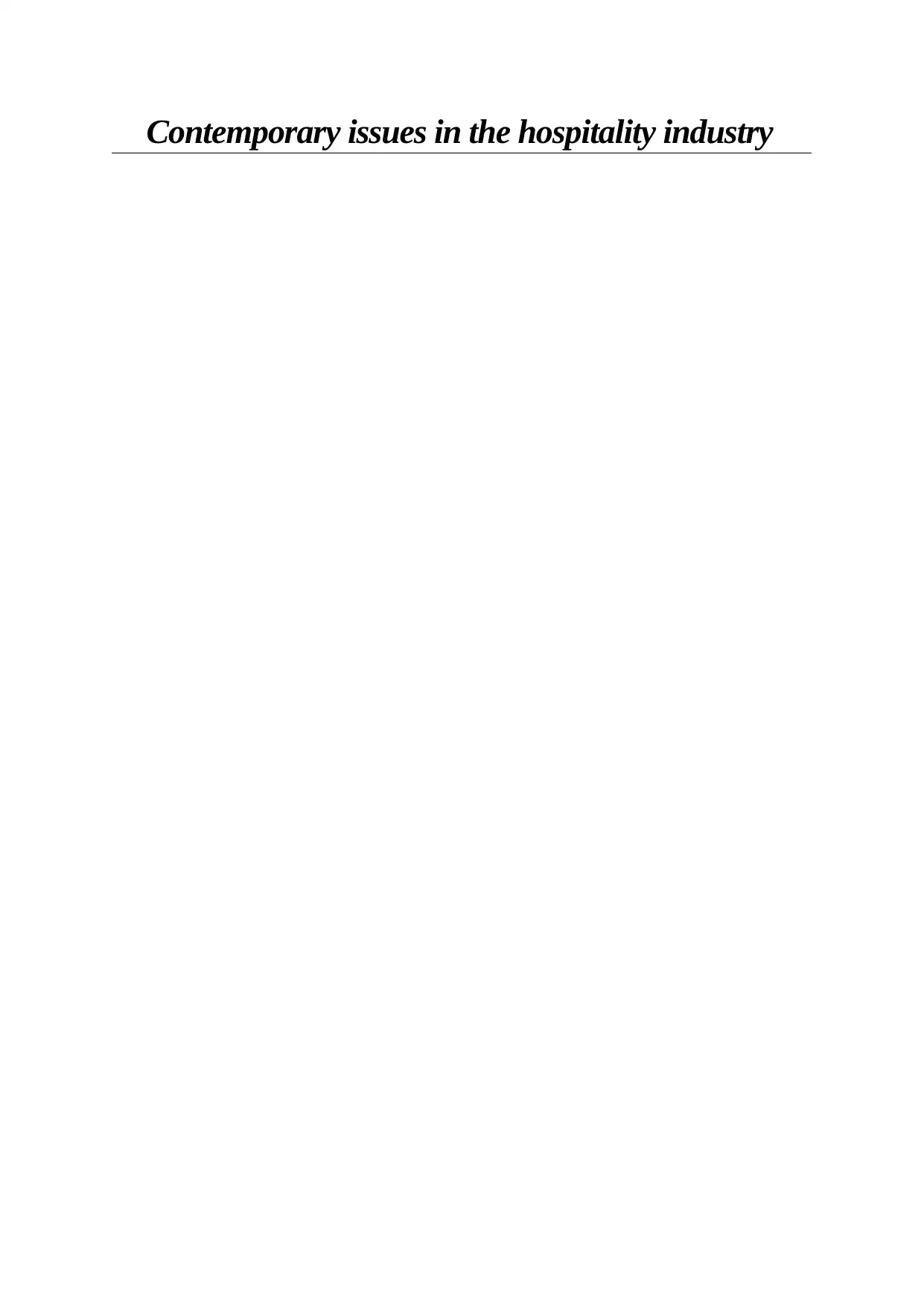
Contemporary issues in the hospitality industry
Paraphrase This Document
Need a fresh take? Get an instant paraphrase of this document with our AI Paraphraser
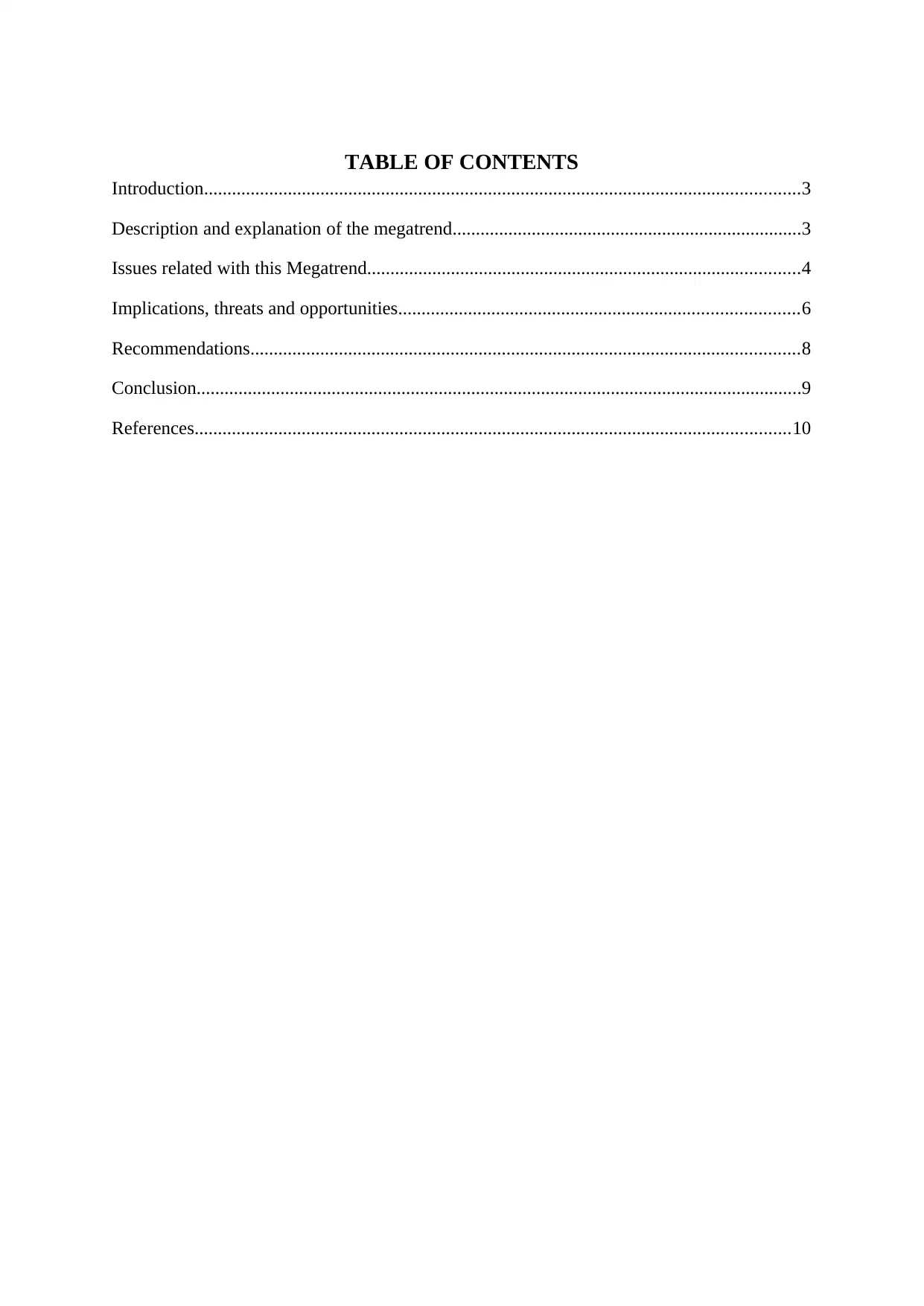
TABLE OF CONTENTS
Introduction................................................................................................................................3
Description and explanation of the megatrend...........................................................................3
Issues related with this Megatrend.............................................................................................4
Implications, threats and opportunities......................................................................................6
Recommendations......................................................................................................................8
Conclusion..................................................................................................................................9
References................................................................................................................................10
Introduction................................................................................................................................3
Description and explanation of the megatrend...........................................................................3
Issues related with this Megatrend.............................................................................................4
Implications, threats and opportunities......................................................................................6
Recommendations......................................................................................................................8
Conclusion..................................................................................................................................9
References................................................................................................................................10
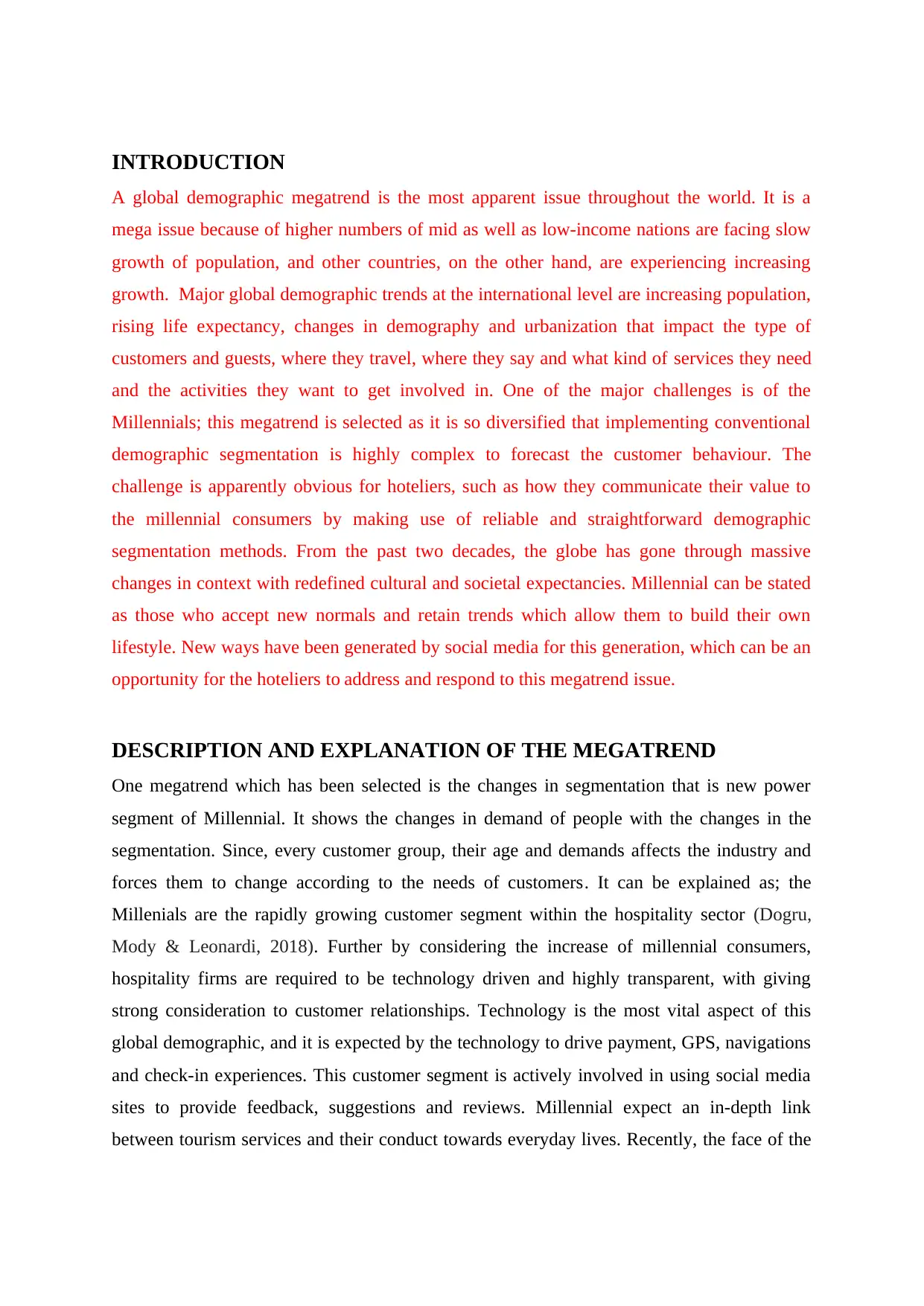
INTRODUCTION
A global demographic megatrend is the most apparent issue throughout the world. It is a
mega issue because of higher numbers of mid as well as low-income nations are facing slow
growth of population, and other countries, on the other hand, are experiencing increasing
growth. Major global demographic trends at the international level are increasing population,
rising life expectancy, changes in demography and urbanization that impact the type of
customers and guests, where they travel, where they say and what kind of services they need
and the activities they want to get involved in. One of the major challenges is of the
Millennials; this megatrend is selected as it is so diversified that implementing conventional
demographic segmentation is highly complex to forecast the customer behaviour. The
challenge is apparently obvious for hoteliers, such as how they communicate their value to
the millennial consumers by making use of reliable and straightforward demographic
segmentation methods. From the past two decades, the globe has gone through massive
changes in context with redefined cultural and societal expectancies. Millennial can be stated
as those who accept new normals and retain trends which allow them to build their own
lifestyle. New ways have been generated by social media for this generation, which can be an
opportunity for the hoteliers to address and respond to this megatrend issue.
DESCRIPTION AND EXPLANATION OF THE MEGATREND
One megatrend which has been selected is the changes in segmentation that is new power
segment of Millennial. It shows the changes in demand of people with the changes in the
segmentation. Since, every customer group, their age and demands affects the industry and
forces them to change according to the needs of customers. It can be explained as; the
Millenials are the rapidly growing customer segment within the hospitality sector (Dogru,
Mody & Leonardi, 2018). Further by considering the increase of millennial consumers,
hospitality firms are required to be technology driven and highly transparent, with giving
strong consideration to customer relationships. Technology is the most vital aspect of this
global demographic, and it is expected by the technology to drive payment, GPS, navigations
and check-in experiences. This customer segment is actively involved in using social media
sites to provide feedback, suggestions and reviews. Millennial expect an in-depth link
between tourism services and their conduct towards everyday lives. Recently, the face of the
A global demographic megatrend is the most apparent issue throughout the world. It is a
mega issue because of higher numbers of mid as well as low-income nations are facing slow
growth of population, and other countries, on the other hand, are experiencing increasing
growth. Major global demographic trends at the international level are increasing population,
rising life expectancy, changes in demography and urbanization that impact the type of
customers and guests, where they travel, where they say and what kind of services they need
and the activities they want to get involved in. One of the major challenges is of the
Millennials; this megatrend is selected as it is so diversified that implementing conventional
demographic segmentation is highly complex to forecast the customer behaviour. The
challenge is apparently obvious for hoteliers, such as how they communicate their value to
the millennial consumers by making use of reliable and straightforward demographic
segmentation methods. From the past two decades, the globe has gone through massive
changes in context with redefined cultural and societal expectancies. Millennial can be stated
as those who accept new normals and retain trends which allow them to build their own
lifestyle. New ways have been generated by social media for this generation, which can be an
opportunity for the hoteliers to address and respond to this megatrend issue.
DESCRIPTION AND EXPLANATION OF THE MEGATREND
One megatrend which has been selected is the changes in segmentation that is new power
segment of Millennial. It shows the changes in demand of people with the changes in the
segmentation. Since, every customer group, their age and demands affects the industry and
forces them to change according to the needs of customers. It can be explained as; the
Millenials are the rapidly growing customer segment within the hospitality sector (Dogru,
Mody & Leonardi, 2018). Further by considering the increase of millennial consumers,
hospitality firms are required to be technology driven and highly transparent, with giving
strong consideration to customer relationships. Technology is the most vital aspect of this
global demographic, and it is expected by the technology to drive payment, GPS, navigations
and check-in experiences. This customer segment is actively involved in using social media
sites to provide feedback, suggestions and reviews. Millennial expect an in-depth link
between tourism services and their conduct towards everyday lives. Recently, the face of the
⊘ This is a preview!⊘
Do you want full access?
Subscribe today to unlock all pages.

Trusted by 1+ million students worldwide
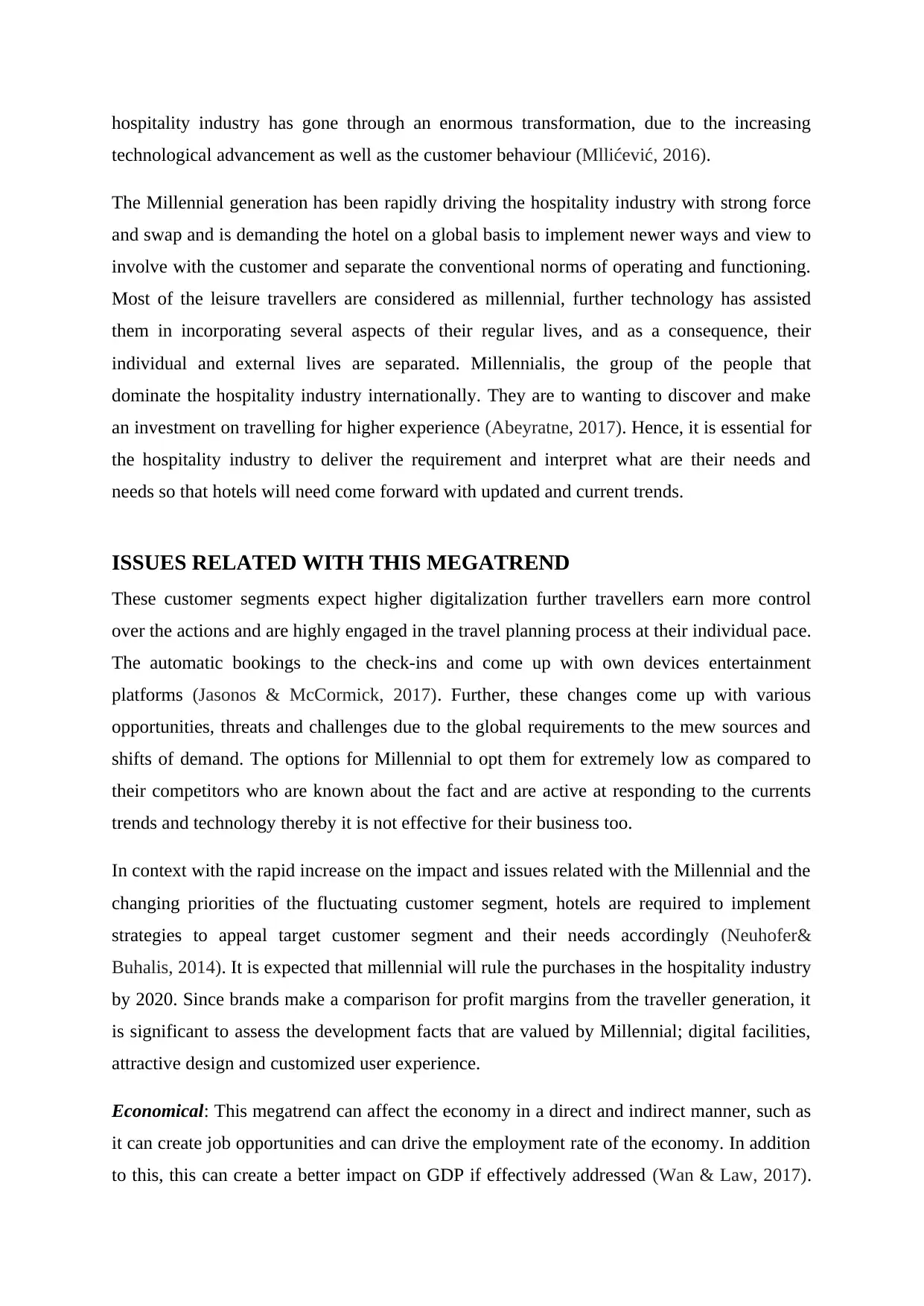
hospitality industry has gone through an enormous transformation, due to the increasing
technological advancement as well as the customer behaviour (Mllićević, 2016).
The Millennial generation has been rapidly driving the hospitality industry with strong force
and swap and is demanding the hotel on a global basis to implement newer ways and view to
involve with the customer and separate the conventional norms of operating and functioning.
Most of the leisure travellers are considered as millennial, further technology has assisted
them in incorporating several aspects of their regular lives, and as a consequence, their
individual and external lives are separated. Millennialis, the group of the people that
dominate the hospitality industry internationally. They are to wanting to discover and make
an investment on travelling for higher experience (Abeyratne, 2017). Hence, it is essential for
the hospitality industry to deliver the requirement and interpret what are their needs and
needs so that hotels will need come forward with updated and current trends.
ISSUES RELATED WITH THIS MEGATREND
These customer segments expect higher digitalization further travellers earn more control
over the actions and are highly engaged in the travel planning process at their individual pace.
The automatic bookings to the check-ins and come up with own devices entertainment
platforms (Jasonos & McCormick, 2017). Further, these changes come up with various
opportunities, threats and challenges due to the global requirements to the mew sources and
shifts of demand. The options for Millennial to opt them for extremely low as compared to
their competitors who are known about the fact and are active at responding to the currents
trends and technology thereby it is not effective for their business too.
In context with the rapid increase on the impact and issues related with the Millennial and the
changing priorities of the fluctuating customer segment, hotels are required to implement
strategies to appeal target customer segment and their needs accordingly (Neuhofer&
Buhalis, 2014). It is expected that millennial will rule the purchases in the hospitality industry
by 2020. Since brands make a comparison for profit margins from the traveller generation, it
is significant to assess the development facts that are valued by Millennial; digital facilities,
attractive design and customized user experience.
Economical: This megatrend can affect the economy in a direct and indirect manner, such as
it can create job opportunities and can drive the employment rate of the economy. In addition
to this, this can create a better impact on GDP if effectively addressed (Wan & Law, 2017).
technological advancement as well as the customer behaviour (Mllićević, 2016).
The Millennial generation has been rapidly driving the hospitality industry with strong force
and swap and is demanding the hotel on a global basis to implement newer ways and view to
involve with the customer and separate the conventional norms of operating and functioning.
Most of the leisure travellers are considered as millennial, further technology has assisted
them in incorporating several aspects of their regular lives, and as a consequence, their
individual and external lives are separated. Millennialis, the group of the people that
dominate the hospitality industry internationally. They are to wanting to discover and make
an investment on travelling for higher experience (Abeyratne, 2017). Hence, it is essential for
the hospitality industry to deliver the requirement and interpret what are their needs and
needs so that hotels will need come forward with updated and current trends.
ISSUES RELATED WITH THIS MEGATREND
These customer segments expect higher digitalization further travellers earn more control
over the actions and are highly engaged in the travel planning process at their individual pace.
The automatic bookings to the check-ins and come up with own devices entertainment
platforms (Jasonos & McCormick, 2017). Further, these changes come up with various
opportunities, threats and challenges due to the global requirements to the mew sources and
shifts of demand. The options for Millennial to opt them for extremely low as compared to
their competitors who are known about the fact and are active at responding to the currents
trends and technology thereby it is not effective for their business too.
In context with the rapid increase on the impact and issues related with the Millennial and the
changing priorities of the fluctuating customer segment, hotels are required to implement
strategies to appeal target customer segment and their needs accordingly (Neuhofer&
Buhalis, 2014). It is expected that millennial will rule the purchases in the hospitality industry
by 2020. Since brands make a comparison for profit margins from the traveller generation, it
is significant to assess the development facts that are valued by Millennial; digital facilities,
attractive design and customized user experience.
Economical: This megatrend can affect the economy in a direct and indirect manner, such as
it can create job opportunities and can drive the employment rate of the economy. In addition
to this, this can create a better impact on GDP if effectively addressed (Wan & Law, 2017).
Paraphrase This Document
Need a fresh take? Get an instant paraphrase of this document with our AI Paraphraser
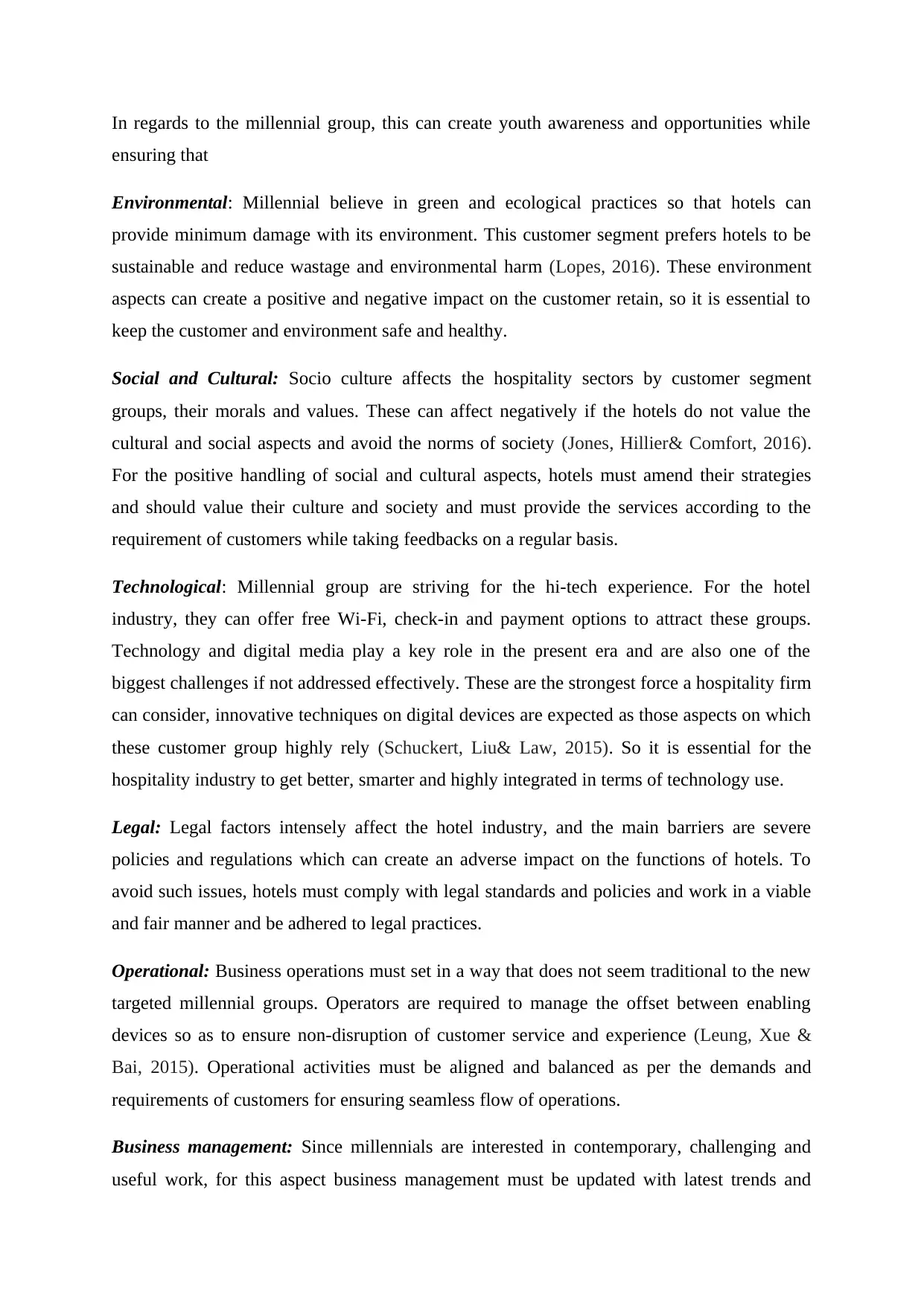
In regards to the millennial group, this can create youth awareness and opportunities while
ensuring that
Environmental: Millennial believe in green and ecological practices so that hotels can
provide minimum damage with its environment. This customer segment prefers hotels to be
sustainable and reduce wastage and environmental harm (Lopes, 2016). These environment
aspects can create a positive and negative impact on the customer retain, so it is essential to
keep the customer and environment safe and healthy.
Social and Cultural: Socio culture affects the hospitality sectors by customer segment
groups, their morals and values. These can affect negatively if the hotels do not value the
cultural and social aspects and avoid the norms of society (Jones, Hillier& Comfort, 2016).
For the positive handling of social and cultural aspects, hotels must amend their strategies
and should value their culture and society and must provide the services according to the
requirement of customers while taking feedbacks on a regular basis.
Technological: Millennial group are striving for the hi-tech experience. For the hotel
industry, they can offer free Wi-Fi, check-in and payment options to attract these groups.
Technology and digital media play a key role in the present era and are also one of the
biggest challenges if not addressed effectively. These are the strongest force a hospitality firm
can consider, innovative techniques on digital devices are expected as those aspects on which
these customer group highly rely (Schuckert, Liu& Law, 2015). So it is essential for the
hospitality industry to get better, smarter and highly integrated in terms of technology use.
Legal: Legal factors intensely affect the hotel industry, and the main barriers are severe
policies and regulations which can create an adverse impact on the functions of hotels. To
avoid such issues, hotels must comply with legal standards and policies and work in a viable
and fair manner and be adhered to legal practices.
Operational: Business operations must set in a way that does not seem traditional to the new
targeted millennial groups. Operators are required to manage the offset between enabling
devices so as to ensure non-disruption of customer service and experience (Leung, Xue &
Bai, 2015). Operational activities must be aligned and balanced as per the demands and
requirements of customers for ensuring seamless flow of operations.
Business management: Since millennials are interested in contemporary, challenging and
useful work, for this aspect business management must be updated with latest trends and
ensuring that
Environmental: Millennial believe in green and ecological practices so that hotels can
provide minimum damage with its environment. This customer segment prefers hotels to be
sustainable and reduce wastage and environmental harm (Lopes, 2016). These environment
aspects can create a positive and negative impact on the customer retain, so it is essential to
keep the customer and environment safe and healthy.
Social and Cultural: Socio culture affects the hospitality sectors by customer segment
groups, their morals and values. These can affect negatively if the hotels do not value the
cultural and social aspects and avoid the norms of society (Jones, Hillier& Comfort, 2016).
For the positive handling of social and cultural aspects, hotels must amend their strategies
and should value their culture and society and must provide the services according to the
requirement of customers while taking feedbacks on a regular basis.
Technological: Millennial group are striving for the hi-tech experience. For the hotel
industry, they can offer free Wi-Fi, check-in and payment options to attract these groups.
Technology and digital media play a key role in the present era and are also one of the
biggest challenges if not addressed effectively. These are the strongest force a hospitality firm
can consider, innovative techniques on digital devices are expected as those aspects on which
these customer group highly rely (Schuckert, Liu& Law, 2015). So it is essential for the
hospitality industry to get better, smarter and highly integrated in terms of technology use.
Legal: Legal factors intensely affect the hotel industry, and the main barriers are severe
policies and regulations which can create an adverse impact on the functions of hotels. To
avoid such issues, hotels must comply with legal standards and policies and work in a viable
and fair manner and be adhered to legal practices.
Operational: Business operations must set in a way that does not seem traditional to the new
targeted millennial groups. Operators are required to manage the offset between enabling
devices so as to ensure non-disruption of customer service and experience (Leung, Xue &
Bai, 2015). Operational activities must be aligned and balanced as per the demands and
requirements of customers for ensuring seamless flow of operations.
Business management: Since millennials are interested in contemporary, challenging and
useful work, for this aspect business management must be updated with latest trends and
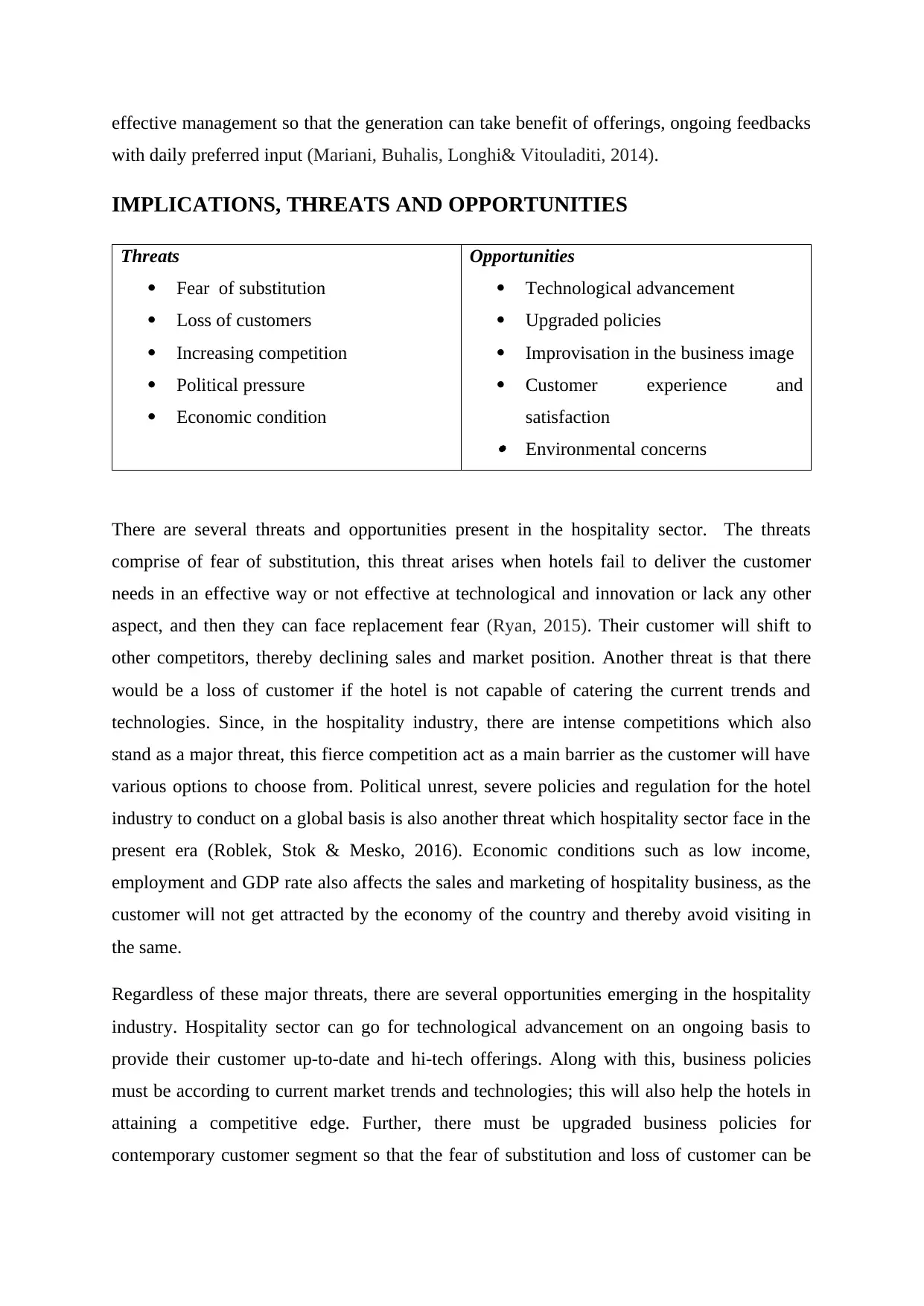
effective management so that the generation can take benefit of offerings, ongoing feedbacks
with daily preferred input (Mariani, Buhalis, Longhi& Vitouladiti, 2014).
IMPLICATIONS, THREATS AND OPPORTUNITIES
Threats
Fear of substitution
Loss of customers
Increasing competition
Political pressure
Economic condition
Opportunities
Technological advancement
Upgraded policies
Improvisation in the business image
Customer experience and
satisfaction
Environmental concerns
There are several threats and opportunities present in the hospitality sector. The threats
comprise of fear of substitution, this threat arises when hotels fail to deliver the customer
needs in an effective way or not effective at technological and innovation or lack any other
aspect, and then they can face replacement fear (Ryan, 2015). Their customer will shift to
other competitors, thereby declining sales and market position. Another threat is that there
would be a loss of customer if the hotel is not capable of catering the current trends and
technologies. Since, in the hospitality industry, there are intense competitions which also
stand as a major threat, this fierce competition act as a main barrier as the customer will have
various options to choose from. Political unrest, severe policies and regulation for the hotel
industry to conduct on a global basis is also another threat which hospitality sector face in the
present era (Roblek, Stok & Mesko, 2016). Economic conditions such as low income,
employment and GDP rate also affects the sales and marketing of hospitality business, as the
customer will not get attracted by the economy of the country and thereby avoid visiting in
the same.
Regardless of these major threats, there are several opportunities emerging in the hospitality
industry. Hospitality sector can go for technological advancement on an ongoing basis to
provide their customer up-to-date and hi-tech offerings. Along with this, business policies
must be according to current market trends and technologies; this will also help the hotels in
attaining a competitive edge. Further, there must be upgraded business policies for
contemporary customer segment so that the fear of substitution and loss of customer can be
with daily preferred input (Mariani, Buhalis, Longhi& Vitouladiti, 2014).
IMPLICATIONS, THREATS AND OPPORTUNITIES
Threats
Fear of substitution
Loss of customers
Increasing competition
Political pressure
Economic condition
Opportunities
Technological advancement
Upgraded policies
Improvisation in the business image
Customer experience and
satisfaction
Environmental concerns
There are several threats and opportunities present in the hospitality sector. The threats
comprise of fear of substitution, this threat arises when hotels fail to deliver the customer
needs in an effective way or not effective at technological and innovation or lack any other
aspect, and then they can face replacement fear (Ryan, 2015). Their customer will shift to
other competitors, thereby declining sales and market position. Another threat is that there
would be a loss of customer if the hotel is not capable of catering the current trends and
technologies. Since, in the hospitality industry, there are intense competitions which also
stand as a major threat, this fierce competition act as a main barrier as the customer will have
various options to choose from. Political unrest, severe policies and regulation for the hotel
industry to conduct on a global basis is also another threat which hospitality sector face in the
present era (Roblek, Stok & Mesko, 2016). Economic conditions such as low income,
employment and GDP rate also affects the sales and marketing of hospitality business, as the
customer will not get attracted by the economy of the country and thereby avoid visiting in
the same.
Regardless of these major threats, there are several opportunities emerging in the hospitality
industry. Hospitality sector can go for technological advancement on an ongoing basis to
provide their customer up-to-date and hi-tech offerings. Along with this, business policies
must be according to current market trends and technologies; this will also help the hotels in
attaining a competitive edge. Further, there must be upgraded business policies for
contemporary customer segment so that the fear of substitution and loss of customer can be
⊘ This is a preview!⊘
Do you want full access?
Subscribe today to unlock all pages.

Trusted by 1+ million students worldwide
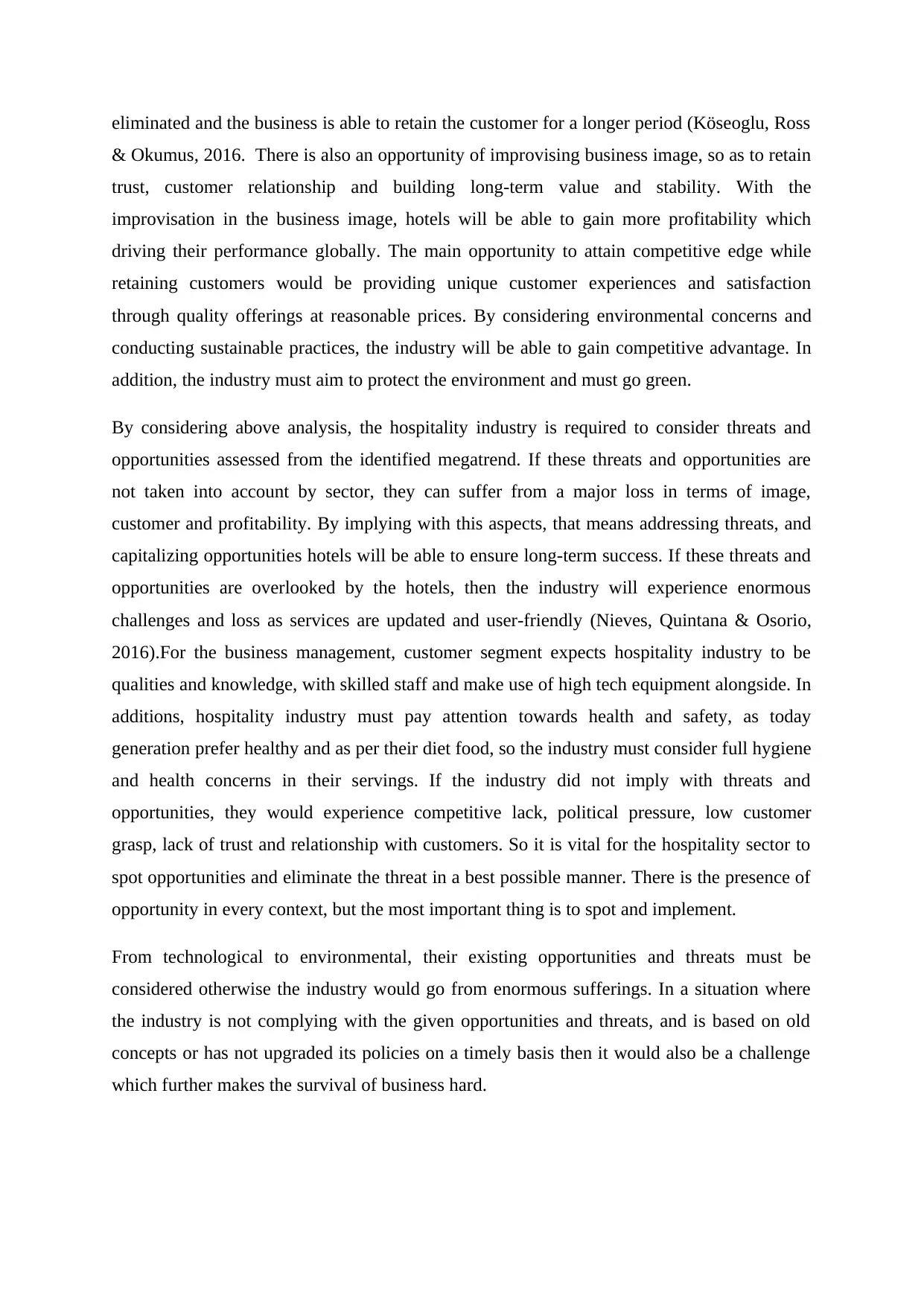
eliminated and the business is able to retain the customer for a longer period (Köseoglu, Ross
& Okumus, 2016. There is also an opportunity of improvising business image, so as to retain
trust, customer relationship and building long-term value and stability. With the
improvisation in the business image, hotels will be able to gain more profitability which
driving their performance globally. The main opportunity to attain competitive edge while
retaining customers would be providing unique customer experiences and satisfaction
through quality offerings at reasonable prices. By considering environmental concerns and
conducting sustainable practices, the industry will be able to gain competitive advantage. In
addition, the industry must aim to protect the environment and must go green.
By considering above analysis, the hospitality industry is required to consider threats and
opportunities assessed from the identified megatrend. If these threats and opportunities are
not taken into account by sector, they can suffer from a major loss in terms of image,
customer and profitability. By implying with this aspects, that means addressing threats, and
capitalizing opportunities hotels will be able to ensure long-term success. If these threats and
opportunities are overlooked by the hotels, then the industry will experience enormous
challenges and loss as services are updated and user-friendly (Nieves, Quintana & Osorio,
2016).For the business management, customer segment expects hospitality industry to be
qualities and knowledge, with skilled staff and make use of high tech equipment alongside. In
additions, hospitality industry must pay attention towards health and safety, as today
generation prefer healthy and as per their diet food, so the industry must consider full hygiene
and health concerns in their servings. If the industry did not imply with threats and
opportunities, they would experience competitive lack, political pressure, low customer
grasp, lack of trust and relationship with customers. So it is vital for the hospitality sector to
spot opportunities and eliminate the threat in a best possible manner. There is the presence of
opportunity in every context, but the most important thing is to spot and implement.
From technological to environmental, their existing opportunities and threats must be
considered otherwise the industry would go from enormous sufferings. In a situation where
the industry is not complying with the given opportunities and threats, and is based on old
concepts or has not upgraded its policies on a timely basis then it would also be a challenge
which further makes the survival of business hard.
& Okumus, 2016. There is also an opportunity of improvising business image, so as to retain
trust, customer relationship and building long-term value and stability. With the
improvisation in the business image, hotels will be able to gain more profitability which
driving their performance globally. The main opportunity to attain competitive edge while
retaining customers would be providing unique customer experiences and satisfaction
through quality offerings at reasonable prices. By considering environmental concerns and
conducting sustainable practices, the industry will be able to gain competitive advantage. In
addition, the industry must aim to protect the environment and must go green.
By considering above analysis, the hospitality industry is required to consider threats and
opportunities assessed from the identified megatrend. If these threats and opportunities are
not taken into account by sector, they can suffer from a major loss in terms of image,
customer and profitability. By implying with this aspects, that means addressing threats, and
capitalizing opportunities hotels will be able to ensure long-term success. If these threats and
opportunities are overlooked by the hotels, then the industry will experience enormous
challenges and loss as services are updated and user-friendly (Nieves, Quintana & Osorio,
2016).For the business management, customer segment expects hospitality industry to be
qualities and knowledge, with skilled staff and make use of high tech equipment alongside. In
additions, hospitality industry must pay attention towards health and safety, as today
generation prefer healthy and as per their diet food, so the industry must consider full hygiene
and health concerns in their servings. If the industry did not imply with threats and
opportunities, they would experience competitive lack, political pressure, low customer
grasp, lack of trust and relationship with customers. So it is vital for the hospitality sector to
spot opportunities and eliminate the threat in a best possible manner. There is the presence of
opportunity in every context, but the most important thing is to spot and implement.
From technological to environmental, their existing opportunities and threats must be
considered otherwise the industry would go from enormous sufferings. In a situation where
the industry is not complying with the given opportunities and threats, and is based on old
concepts or has not upgraded its policies on a timely basis then it would also be a challenge
which further makes the survival of business hard.
Paraphrase This Document
Need a fresh take? Get an instant paraphrase of this document with our AI Paraphraser
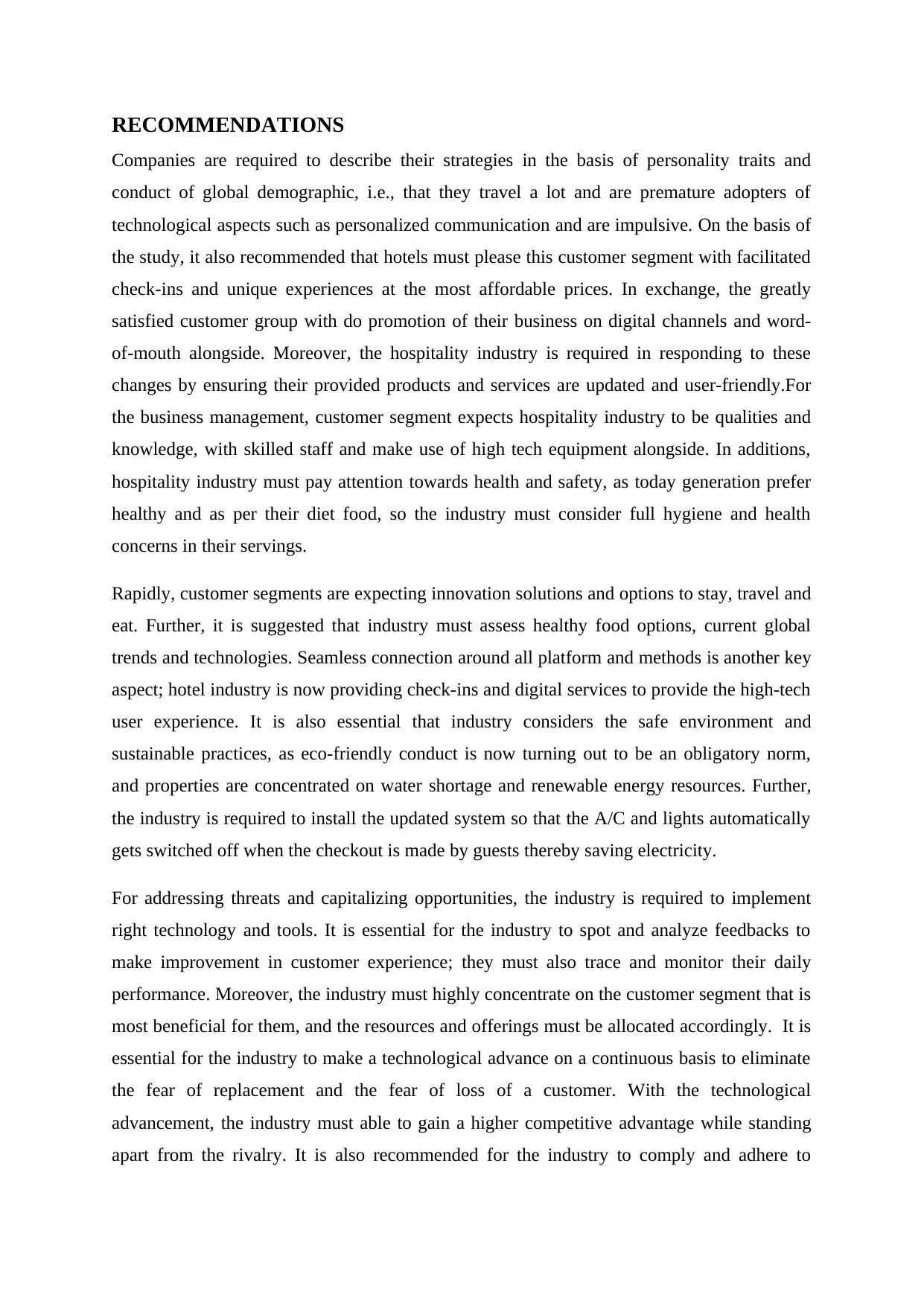
RECOMMENDATIONS
Companies are required to describe their strategies in the basis of personality traits and
conduct of global demographic, i.e., that they travel a lot and are premature adopters of
technological aspects such as personalized communication and are impulsive. On the basis of
the study, it also recommended that hotels must please this customer segment with facilitated
check-ins and unique experiences at the most affordable prices. In exchange, the greatly
satisfied customer group with do promotion of their business on digital channels and word-
of-mouth alongside. Moreover, the hospitality industry is required in responding to these
changes by ensuring their provided products and services are updated and user-friendly.For
the business management, customer segment expects hospitality industry to be qualities and
knowledge, with skilled staff and make use of high tech equipment alongside. In additions,
hospitality industry must pay attention towards health and safety, as today generation prefer
healthy and as per their diet food, so the industry must consider full hygiene and health
concerns in their servings.
Rapidly, customer segments are expecting innovation solutions and options to stay, travel and
eat. Further, it is suggested that industry must assess healthy food options, current global
trends and technologies. Seamless connection around all platform and methods is another key
aspect; hotel industry is now providing check-ins and digital services to provide the high-tech
user experience. It is also essential that industry considers the safe environment and
sustainable practices, as eco-friendly conduct is now turning out to be an obligatory norm,
and properties are concentrated on water shortage and renewable energy resources. Further,
the industry is required to install the updated system so that the A/C and lights automatically
gets switched off when the checkout is made by guests thereby saving electricity.
For addressing threats and capitalizing opportunities, the industry is required to implement
right technology and tools. It is essential for the industry to spot and analyze feedbacks to
make improvement in customer experience; they must also trace and monitor their daily
performance. Moreover, the industry must highly concentrate on the customer segment that is
most beneficial for them, and the resources and offerings must be allocated accordingly. It is
essential for the industry to make a technological advance on a continuous basis to eliminate
the fear of replacement and the fear of loss of a customer. With the technological
advancement, the industry must able to gain a higher competitive advantage while standing
apart from the rivalry. It is also recommended for the industry to comply and adhere to
Companies are required to describe their strategies in the basis of personality traits and
conduct of global demographic, i.e., that they travel a lot and are premature adopters of
technological aspects such as personalized communication and are impulsive. On the basis of
the study, it also recommended that hotels must please this customer segment with facilitated
check-ins and unique experiences at the most affordable prices. In exchange, the greatly
satisfied customer group with do promotion of their business on digital channels and word-
of-mouth alongside. Moreover, the hospitality industry is required in responding to these
changes by ensuring their provided products and services are updated and user-friendly.For
the business management, customer segment expects hospitality industry to be qualities and
knowledge, with skilled staff and make use of high tech equipment alongside. In additions,
hospitality industry must pay attention towards health and safety, as today generation prefer
healthy and as per their diet food, so the industry must consider full hygiene and health
concerns in their servings.
Rapidly, customer segments are expecting innovation solutions and options to stay, travel and
eat. Further, it is suggested that industry must assess healthy food options, current global
trends and technologies. Seamless connection around all platform and methods is another key
aspect; hotel industry is now providing check-ins and digital services to provide the high-tech
user experience. It is also essential that industry considers the safe environment and
sustainable practices, as eco-friendly conduct is now turning out to be an obligatory norm,
and properties are concentrated on water shortage and renewable energy resources. Further,
the industry is required to install the updated system so that the A/C and lights automatically
gets switched off when the checkout is made by guests thereby saving electricity.
For addressing threats and capitalizing opportunities, the industry is required to implement
right technology and tools. It is essential for the industry to spot and analyze feedbacks to
make improvement in customer experience; they must also trace and monitor their daily
performance. Moreover, the industry must highly concentrate on the customer segment that is
most beneficial for them, and the resources and offerings must be allocated accordingly. It is
essential for the industry to make a technological advance on a continuous basis to eliminate
the fear of replacement and the fear of loss of a customer. With the technological
advancement, the industry must able to gain a higher competitive advantage while standing
apart from the rivalry. It is also recommended for the industry to comply and adhere to
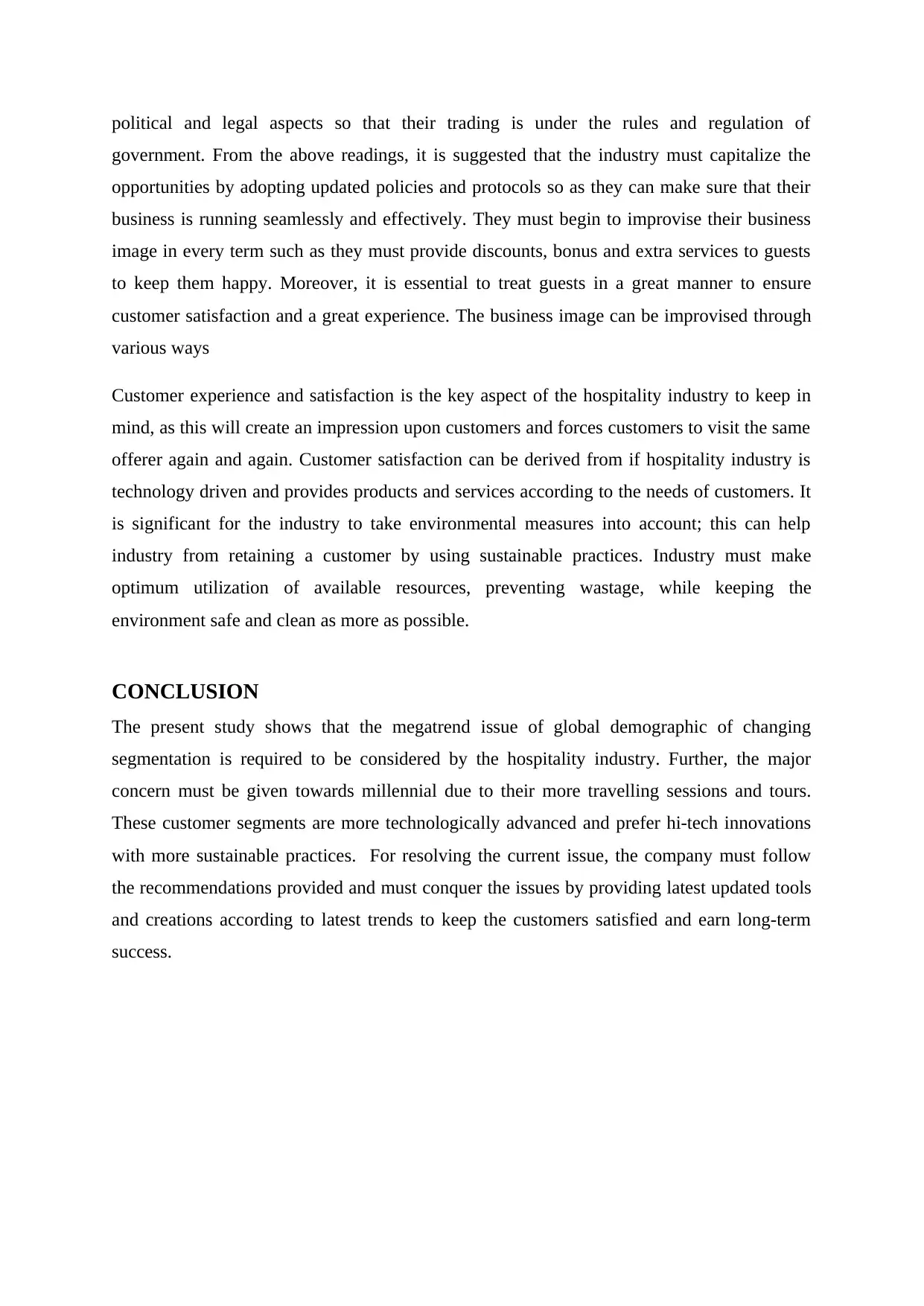
political and legal aspects so that their trading is under the rules and regulation of
government. From the above readings, it is suggested that the industry must capitalize the
opportunities by adopting updated policies and protocols so as they can make sure that their
business is running seamlessly and effectively. They must begin to improvise their business
image in every term such as they must provide discounts, bonus and extra services to guests
to keep them happy. Moreover, it is essential to treat guests in a great manner to ensure
customer satisfaction and a great experience. The business image can be improvised through
various ways
Customer experience and satisfaction is the key aspect of the hospitality industry to keep in
mind, as this will create an impression upon customers and forces customers to visit the same
offerer again and again. Customer satisfaction can be derived from if hospitality industry is
technology driven and provides products and services according to the needs of customers. It
is significant for the industry to take environmental measures into account; this can help
industry from retaining a customer by using sustainable practices. Industry must make
optimum utilization of available resources, preventing wastage, while keeping the
environment safe and clean as more as possible.
CONCLUSION
The present study shows that the megatrend issue of global demographic of changing
segmentation is required to be considered by the hospitality industry. Further, the major
concern must be given towards millennial due to their more travelling sessions and tours.
These customer segments are more technologically advanced and prefer hi-tech innovations
with more sustainable practices. For resolving the current issue, the company must follow
the recommendations provided and must conquer the issues by providing latest updated tools
and creations according to latest trends to keep the customers satisfied and earn long-term
success.
government. From the above readings, it is suggested that the industry must capitalize the
opportunities by adopting updated policies and protocols so as they can make sure that their
business is running seamlessly and effectively. They must begin to improvise their business
image in every term such as they must provide discounts, bonus and extra services to guests
to keep them happy. Moreover, it is essential to treat guests in a great manner to ensure
customer satisfaction and a great experience. The business image can be improvised through
various ways
Customer experience and satisfaction is the key aspect of the hospitality industry to keep in
mind, as this will create an impression upon customers and forces customers to visit the same
offerer again and again. Customer satisfaction can be derived from if hospitality industry is
technology driven and provides products and services according to the needs of customers. It
is significant for the industry to take environmental measures into account; this can help
industry from retaining a customer by using sustainable practices. Industry must make
optimum utilization of available resources, preventing wastage, while keeping the
environment safe and clean as more as possible.
CONCLUSION
The present study shows that the megatrend issue of global demographic of changing
segmentation is required to be considered by the hospitality industry. Further, the major
concern must be given towards millennial due to their more travelling sessions and tours.
These customer segments are more technologically advanced and prefer hi-tech innovations
with more sustainable practices. For resolving the current issue, the company must follow
the recommendations provided and must conquer the issues by providing latest updated tools
and creations according to latest trends to keep the customers satisfied and earn long-term
success.
⊘ This is a preview!⊘
Do you want full access?
Subscribe today to unlock all pages.

Trusted by 1+ million students worldwide
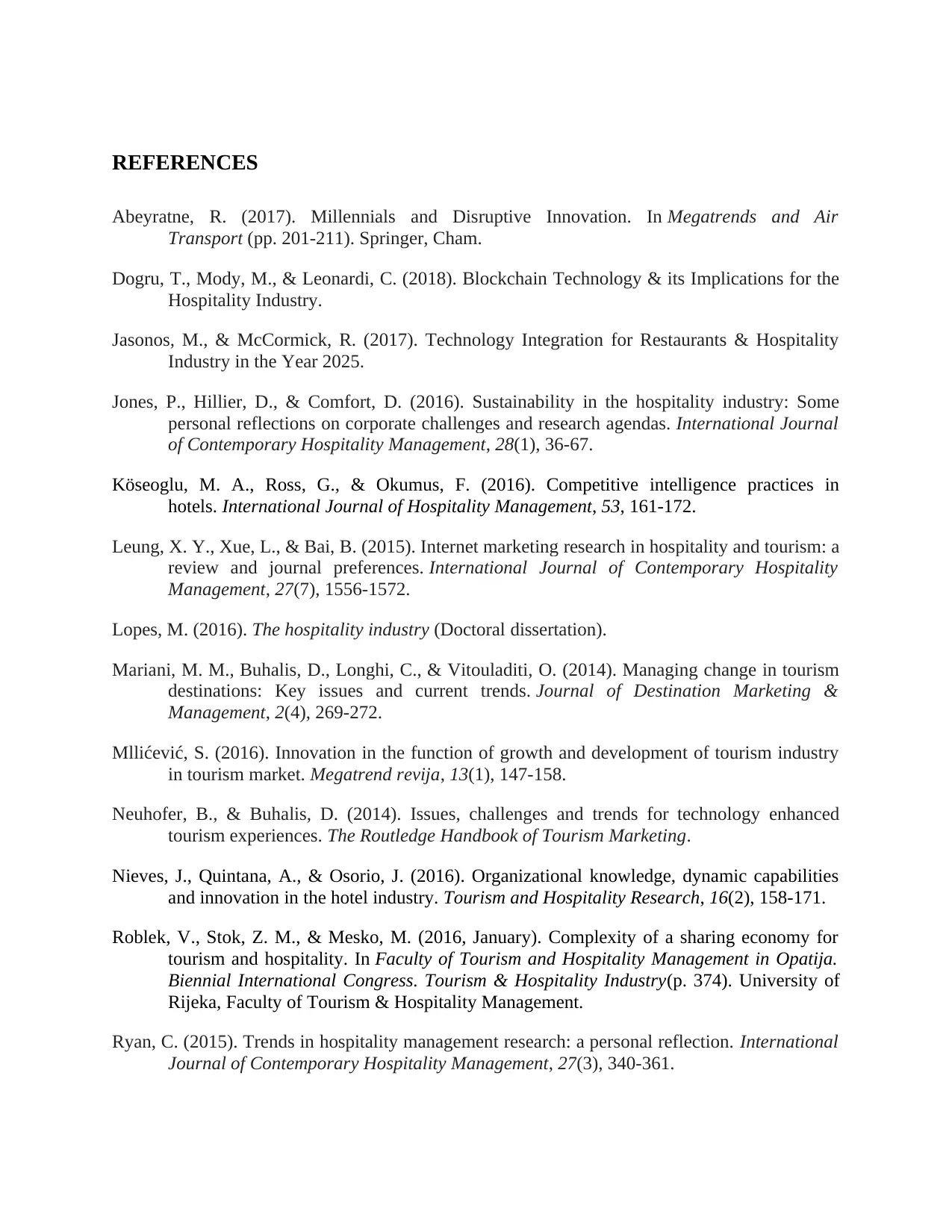
REFERENCES
Abeyratne, R. (2017). Millennials and Disruptive Innovation. In Megatrends and Air
Transport (pp. 201-211). Springer, Cham.
Dogru, T., Mody, M., & Leonardi, C. (2018). Blockchain Technology & its Implications for the
Hospitality Industry.
Jasonos, M., & McCormick, R. (2017). Technology Integration for Restaurants & Hospitality
Industry in the Year 2025.
Jones, P., Hillier, D., & Comfort, D. (2016). Sustainability in the hospitality industry: Some
personal reflections on corporate challenges and research agendas. International Journal
of Contemporary Hospitality Management, 28(1), 36-67.
Köseoglu, M. A., Ross, G., & Okumus, F. (2016). Competitive intelligence practices in
hotels. International Journal of Hospitality Management, 53, 161-172.
Leung, X. Y., Xue, L., & Bai, B. (2015). Internet marketing research in hospitality and tourism: a
review and journal preferences. International Journal of Contemporary Hospitality
Management, 27(7), 1556-1572.
Lopes, M. (2016). The hospitality industry (Doctoral dissertation).
Mariani, M. M., Buhalis, D., Longhi, C., & Vitouladiti, O. (2014). Managing change in tourism
destinations: Key issues and current trends. Journal of Destination Marketing &
Management, 2(4), 269-272.
Mllićević, S. (2016). Innovation in the function of growth and development of tourism industry
in tourism market. Megatrend revija, 13(1), 147-158.
Neuhofer, B., & Buhalis, D. (2014). Issues, challenges and trends for technology enhanced
tourism experiences. The Routledge Handbook of Tourism Marketing.
Nieves, J., Quintana, A., & Osorio, J. (2016). Organizational knowledge, dynamic capabilities
and innovation in the hotel industry. Tourism and Hospitality Research, 16(2), 158-171.
Roblek, V., Stok, Z. M., & Mesko, M. (2016, January). Complexity of a sharing economy for
tourism and hospitality. In Faculty of Tourism and Hospitality Management in Opatija.
Biennial International Congress. Tourism & Hospitality Industry(p. 374). University of
Rijeka, Faculty of Tourism & Hospitality Management.
Ryan, C. (2015). Trends in hospitality management research: a personal reflection. International
Journal of Contemporary Hospitality Management, 27(3), 340-361.
Abeyratne, R. (2017). Millennials and Disruptive Innovation. In Megatrends and Air
Transport (pp. 201-211). Springer, Cham.
Dogru, T., Mody, M., & Leonardi, C. (2018). Blockchain Technology & its Implications for the
Hospitality Industry.
Jasonos, M., & McCormick, R. (2017). Technology Integration for Restaurants & Hospitality
Industry in the Year 2025.
Jones, P., Hillier, D., & Comfort, D. (2016). Sustainability in the hospitality industry: Some
personal reflections on corporate challenges and research agendas. International Journal
of Contemporary Hospitality Management, 28(1), 36-67.
Köseoglu, M. A., Ross, G., & Okumus, F. (2016). Competitive intelligence practices in
hotels. International Journal of Hospitality Management, 53, 161-172.
Leung, X. Y., Xue, L., & Bai, B. (2015). Internet marketing research in hospitality and tourism: a
review and journal preferences. International Journal of Contemporary Hospitality
Management, 27(7), 1556-1572.
Lopes, M. (2016). The hospitality industry (Doctoral dissertation).
Mariani, M. M., Buhalis, D., Longhi, C., & Vitouladiti, O. (2014). Managing change in tourism
destinations: Key issues and current trends. Journal of Destination Marketing &
Management, 2(4), 269-272.
Mllićević, S. (2016). Innovation in the function of growth and development of tourism industry
in tourism market. Megatrend revija, 13(1), 147-158.
Neuhofer, B., & Buhalis, D. (2014). Issues, challenges and trends for technology enhanced
tourism experiences. The Routledge Handbook of Tourism Marketing.
Nieves, J., Quintana, A., & Osorio, J. (2016). Organizational knowledge, dynamic capabilities
and innovation in the hotel industry. Tourism and Hospitality Research, 16(2), 158-171.
Roblek, V., Stok, Z. M., & Mesko, M. (2016, January). Complexity of a sharing economy for
tourism and hospitality. In Faculty of Tourism and Hospitality Management in Opatija.
Biennial International Congress. Tourism & Hospitality Industry(p. 374). University of
Rijeka, Faculty of Tourism & Hospitality Management.
Ryan, C. (2015). Trends in hospitality management research: a personal reflection. International
Journal of Contemporary Hospitality Management, 27(3), 340-361.
Paraphrase This Document
Need a fresh take? Get an instant paraphrase of this document with our AI Paraphraser
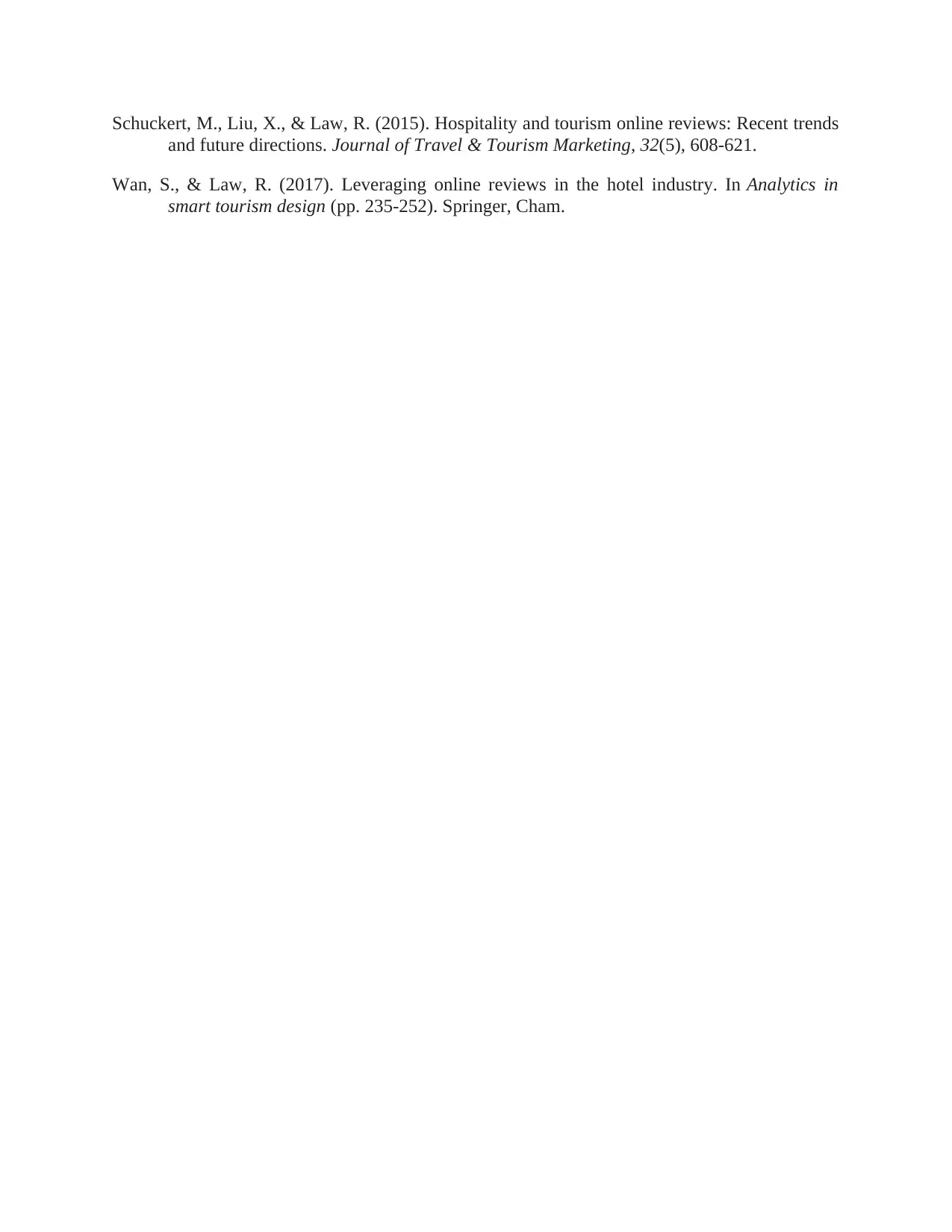
Schuckert, M., Liu, X., & Law, R. (2015). Hospitality and tourism online reviews: Recent trends
and future directions. Journal of Travel & Tourism Marketing, 32(5), 608-621.
Wan, S., & Law, R. (2017). Leveraging online reviews in the hotel industry. In Analytics in
smart tourism design (pp. 235-252). Springer, Cham.
and future directions. Journal of Travel & Tourism Marketing, 32(5), 608-621.
Wan, S., & Law, R. (2017). Leveraging online reviews in the hotel industry. In Analytics in
smart tourism design (pp. 235-252). Springer, Cham.
1 out of 11
Related Documents
Your All-in-One AI-Powered Toolkit for Academic Success.
+13062052269
info@desklib.com
Available 24*7 on WhatsApp / Email
![[object Object]](/_next/static/media/star-bottom.7253800d.svg)
Unlock your academic potential
Copyright © 2020–2025 A2Z Services. All Rights Reserved. Developed and managed by ZUCOL.





